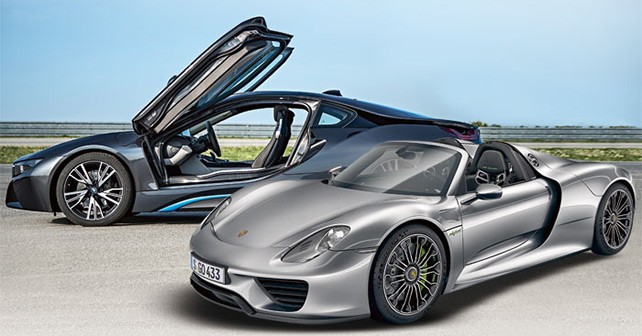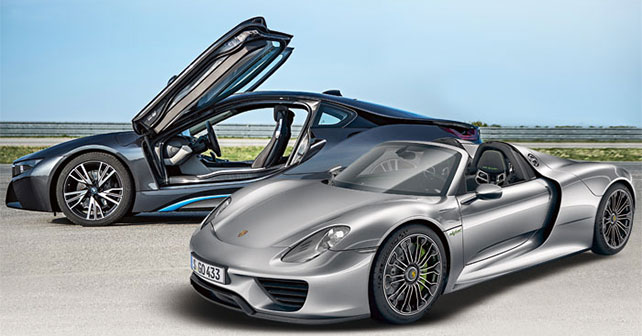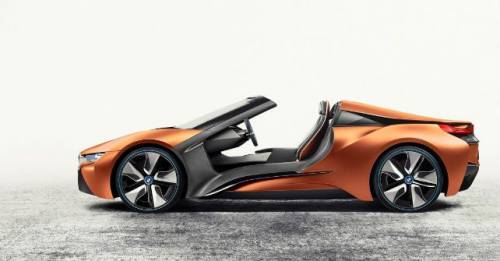
The combination of petrol and electric engines are raising the technical (and sensory) bar. But don’t forget the contribution of light materials, innovative frames, and bold design.
The Porsche 918 Spyder, with its electric propulsion, only hits a max speed of 150km/h. But if it summons the petrol engine, it delivers over 880bhp while hitting 340km/h, and burns through the 0-100km/h sprint in a mere 2.8 seconds – all of this against a declared consumption of approximately 3 litres per 100 km. The BMW i8 (362bhp), instead, boasts of an acceleration of 4.4 seconds on a mere 2.5 litres per 100kms. These figures indicate that the technological challenge is entering new terrain. Both cars are plug-in hybrids, daughters of radically new projects designed from scratch. Both make extensive use of lightweight materials, and are high expressions of state-of-the-art research on the mixed petrol-battery engine.
2 to 1 in favour of Stuttgart
But here we’re obviously talking about two fascinating sport cars, which, beyond the stupefying figures, promise riveting sensations. They are finally ready to hit the roads (and the garages of the usual happy few) after months of announcements and partial revelations. Both have all-wheel drive, thanks to the use of an electric motor at the front. The only petrol engine is at the back, but, while for the BMW it’s a 1.5 litre, 321bhp, 3-cylinder TwinPower turbo that powers the rear wheels through a six-speed automatic transmission, Porsche has decided to go with a more traditional 4.6, 8-cylider with a good 608bhp (derived from racing experience), along with a second electric motor – in addition to the one at the front – which works on the rear axle in combination with the petrol engine. In charge of transferring the torque is the familiar 7-speed, double-clutch PDK transmission.
Five Souls
Both cars are expected to have five different driving programs. At start, the Porsche automatically selects the electric mode that, with its batteries fully-charged, allows the driver to travel at zero emissions for a minimum of 16, and a maximum of 24, kilometres. But, by pressing a button, you can choose any of the other four programs – Hybrid, in which the combustion engine and the two electric engines work towards max efficiency; Sport Hybrid, which engages the V8 continuously as the primary means of propulsion, with the electrical units intervening to support acceleration; Race Hybrid, meant to maximize the supply of the petrol engine and electric motor; and, finally, Hot Lap, which, for a limited interval, allows the car to squeeze out all the power of the electrical units, thus depleting the battery.
The BMW, when turned on, automatically activates Comfort mode, which (guaranteeing 500 kilometres of range on a ‘full’ tank and charge) attempts to balance efficiency and performance. By selecting the EcoPro mode, you favour the first, while in Sport you favour the second. Lastly, the eDrive button, which is separate from Comfort and EcoPro, normally excludes the petrol engine (except in the case of kick-down or exhaustion of the battery reserve). Light weight, combined with the suspension management systems of PASM (in the Porsche) and dynamic damper control (in the BMW), ensure an engaging drive. And there are many technological goodies to savour – two above all, the 918 Spyder’s rear wheel steering, and the (optional) laser headlights of the i8. A hundred times more intense than LED’s, they are a breakthrough in the auto world.
BMW i8
Coupe 2+2, 1,490 kilos, double-wishbone suspension in front, multilink at the back, hybrid plug-in system with 3-cylinder, 1.5 TwinPower turbo (231bhp) & synchronous motor (131bhp), and 6-speed automatic transmission.
PORSCHE 918 Spyder
‘Targa’ (removable hardtop), two-seater, 1,640 kilos, wishbones in the front and multilink behind (with rear wheel steering), hybrid plug-in system with a 4.6 liter V8 (608bhp) engine and two electrical units (156 and 129bhp), and 7-gear PDK transmission.
The force of carbonium
Not only the passenger tub, but the entire structure of the 918 is made of CFRP (carbon fibre reinforced polymer). The i8 also makes extensive use of it – the passenger area and door frames are carbon, covered by a sheet of aluminium.
The car in layers
Innovative also in the way it looks, the i8 has a lower module of aluminium that holds the mechanicals, and a top module of CFRP that encloses a passenger area.
Between tradition and modernity
The stylistic signature of all BMW interiors are present in the passenger area of the i8, but reinterpreted with an eye towards the future, and with a design that exalts the lightness of the mechanical components. On the centre console, there’s the usual i-Drive control knob.
Under the Porsche’s skin
Mid-mounted petrol V8 is mated to an electric motor. There’s another battery-powered electric motor in front. Weight distribution is 43% in front and 57% in the back.
To the heart of the BMW
1.5 litre engine at the rear, electric motor in front, batteries in the tunnel, 50:50 weight distribution.
Sophisticated Essence
The centre console of the 918 Spyder makes a great visual impact, as it holds all the infotainment functions. The drive buttons, however, are assembled on the steering wheel.
Mercedes S
MERCEDES-BENZ S COUPE
Unveiled at the Frankfurt Motor Show, the S Coupe reveals the form of a new flagship sport model for the Three-Pointed Star – the first one with touch-pad technology.
With its 5 metres of length, it won’t be a champion of lightness. And with the bi-turbo petrol V8, which powered the concept model displayed this year in Frankfurt, neither will it be a paragon of eco-friendliness. But, when it hits the market in 2014, the S Coupe will nevertheless be a nice bundle of technology. Gifted with all the systems that have come out recently on the new S sedan, it could also inherit the hybrid system of the new plug-in S500 – also unveiled at Frankfurt – which links a 333bhp turbo V6 to a 108bhp electric unit. But it’s on the inside that intriguing novelties are expected – the S Coupe could be the first Mercedes with touch-pad technology – a touch panel (like on tablets).
© Riproduzione riservata
































Write your Comment